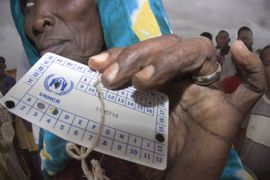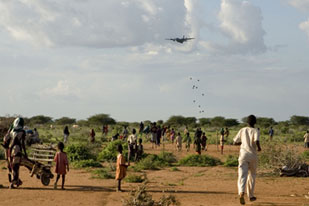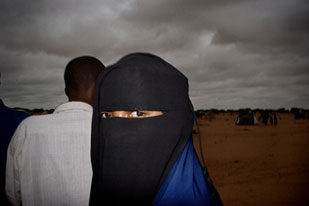Fever threatens Somali refugees
Deadly River Valley Fever spreading through flood-hit northeast Kenya.

 |
| Aid organisations have been dropping food, medicines and other equipment to refugees in Kenya [UNHCR] |
Despite several airdrops of foodstuffs, medicines and emergency equipment to thousands of Somali refugees hit by heavy rains, relief organisations in northeastern Kenya are racing against the clock to forestall a humanitarian crisis.
The refugees, who are mostly women and children, have in past years fled escalating unrest in Somalia, particularly in its port cities and the capital, Mogadishu.
Keep reading
list of 4 itemsAre seed-sowing drones the answer to global deforestation?
Rainfall set to help crews battling wildfire near Canada’s Fort McMurray
The Alabama town living and dying in the shadow of chemical plants
They arrive at the camps set up by the United Nations High Commissioner for Refugees (UNHCR) suffering from extreme fatigue and malnutrition.
However, two months of heavy rain and severe flooding has now uprooted thousands of them living in several camps located in Dadaab, 200km from the Somalia-Kenya border.
And in the past month, they have faced a new danger – the highly contagious Rift Valley Fever (RVF) which has killed 57 people in Wajir District, 500km north of the capital Nairobi.
Further compounding the situation, health officials in Garissa, the largest town in Northeastern Kenya and the main transit point for most of the refugees, have reported growing pandemonium born out of people’s fear of contracting the disease.
Joseph Munyao, Kenya’s minister of livestock, told Al Jazeera: “We are asking the residents and refugees not to move from one place to the other and to avoid contact with the animals until the disease is contained.”
Affecting livestock
RVF is a viral haemorrhagic fever that affects livestock, especially cattle, goats and sheep. As it is spread between animals and humans largely through infected mosquitoes, the disease is particularly contagious during the rainy season and threatens mostly the pastoral societies that traditionally roam Kenya’s northeast.
| “In our case, the disease is spread from animals to humans not only by mosquitoes, but also through contact with the blood, fluids or organs of infected animals.”
Dr Abija Abdalla, |
“In our case, the disease is spread from animals to humans not only by mosquitoes, but also through contact with the blood, fluids or organs of infected animals,” Dr Abija Abdalla, a medical superintendent at the Garissa General Hospital, said.
Drinking raw milk from an infected animal can also spread the infection to humans.
In 1997, RVF killed more than 300 people in Kenya after heavy rains and severe flooding caused by that year’s El Nino, a meteorological phenomenon associated with major fluctuations in Pacific Ocean surface temperatures, resulting in unpredictable weather worldwide.
Symptoms of RVF, which mimic those of the Ebola virus, include high fever, yellowing of the eyes, vomiting blood, diarrhoea, swelling of the limbs and bleeding through the orifices of the body; symptoms that, in most cases, if not treated immediately, often prove fatal.
“Most patients that were brought to the hospital with these symptoms died within 48 hours,” Ahmed Abdullahi, the head nurse of Garissa district hospital, said.
Succumbing to disease
Over the Christmas weekend alone, eight more herdsmen succumbed to the disease and on January 5, health officials reported three more deaths in Garissa while another three other deaths have been reported in neighbouring Isiolo District.
 |
| More than one million people are suffering from the effects of flooding in northeast Kenya [WIR Pictures] |
“Currently there are eight people admitted at the Garissa District Hospital who are fighting the disease,” Abdullahi said.
“Our main concern right now is to quarantine those already infected and to intensify our surveillance of the entire province so that we can contain and prevent the disease from spreading to the rest of the region.”
The patients from the region are being kept under mosquito nets at all times.
In a bid to contain the disease, the Kenyan government has launched a campaign to distribute 10,000 insecticide treated nets in addition to those distributed from emergency air drops in the region.
Containment measures
Other containment measures have included the wide-scale spraying of insecticide in infected areas and the distribution of medical supplies.
“Surveillance centres have been set up, monitoring those travelling in and out of Garissa to ensure that the disease does not spread to other areas, or to the rest of the country,” Abdullahi said.
| I would estimate, conservatively, that about 400,000 people have been directly affected by the flooding in Somalia alone.” |
But this is a region that has long been overwhelmed by severe weather patterns, often with deadly consequences.
The heavy rains which have plagued this area of Kenya since October came after a five-year drought had already extracted a heavy toll in humans and livestock.
Stagnant pools left by the floodwaters make for an ideal mosquito larvae breeding ground. With rudimentary sewage facilities overwhelmed by flooding, there is also fear of any number of other waterborne diseases, such as cholera, dysentery, hepatitis and typhoid, among others.
Seeking higher ground
Mohamed Qazilbash, senior sector co-ordinator for CARE International in Dadaab, told Al Jazeera: “With the flooding this bad, and a majority of the refugees left without food and shelter … our biggest, initial concern has been moving the refugees to higher ground.”
In October, thousands of refugees fearing starvation and a potential polio outbreak returned to Somalia, but the continuing flooding has halted all movement.
“As much as we might feel adversely affected by the floods, the refugees are aware that the situation across the border is even worse. With so many Somalis displaced, we fear a new wave of refugees once the waters have receded and road is repaired. I would estimate, conservatively, that about 400,000 people have been directly affected by the flooding in Somalia alone,” Qazilbash said.
Road access difficult
In the meantime, however, the Kenyan government as well as various NGOs and relief organisations have been trying to contend with road networks nearly destroyed by the heavy rains.
 |
| Heavy rains came after years of drought in the region [WIR Pictures] |
The land, parched by years of drought, has been unable to absorb the torrential rains that began in late October and seem set to continue indefinitely.
The only road connecting the refugee camps to the rest of the country, rutted and treacherous under the best of conditions, has been decimated, cutting the camps off from vital deliveries of supplies.
Julius Onyango, a programme support manager for CARE International in Dadaab said: “There is no other option but airdropping to get help into Dadaab, as the road to Garissa is nearly impassable.”
Dozens of World Food Programme (WFP) trucks carrying food, water, medicine and other essentials have been unable to reach the camps, he explained.
Airdrops
As a result, US Air Force C-130 Hercules cargo planes began dropping the most urgently needed materials like tarpaulins, medicine, plastic sheeting, mosquito nets and tents to the refugee community in Dadaab.
For refugees who have lost their homes to flooding, emergency building materials and mosquito nets are as essential as food, protecting them against the elements and infection.
Last week, the WFP also started dropping water and food supplies along the Kenya and Somali border, intensifying its land, water and air campaign to provide assistance for more than a million people suffering effects of the floods.
On 29 December, 14 tonnes of maize were dropped to the northeastern districts.
So complex has the conflict in Somalia become, it is in danger of engulfing the entire region, with terrible circumstances for refugees and internally displaced people both sides of the border.
While the fighting in Somalia may have subsided somewhat in recent days the camps remain totally isolated from deliveries by road.
With overwhelmed aid infrastructure and future airdrops remaining uncertain, these districts, and the refugees that populate them, are caught between the options of war, famine and outbreak.